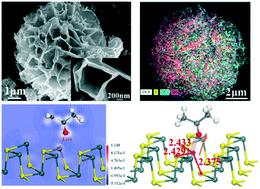当前位置:
X-MOL 学术
›
Environ. Sci.: Nano
›
论文详情
Our official English website, www.x-mol.net, welcomes your
feedback! (Note: you will need to create a separate account there.)
Boosting the acetone sensing of SnS nanoflakes by spin Mn substitution: a novel adsorption–desorption perspective
Environmental Science: Nano ( IF 5.8 ) Pub Date : 2021-3-31 , DOI: 10.1039/d0en01251c Yinan Bai 1, 2, 3, 4 , Yuxiang Qin 1, 2, 3, 4, 5 , Peilun Qiu 1, 2, 3, 4
Environmental Science: Nano ( IF 5.8 ) Pub Date : 2021-3-31 , DOI: 10.1039/d0en01251c Yinan Bai 1, 2, 3, 4 , Yuxiang Qin 1, 2, 3, 4, 5 , Peilun Qiu 1, 2, 3, 4
Affiliation

|
Two-dimensional ultrathin tin monosulfide (SnS) nanoflakes have shown promise for gas-sensing applications thanks to their excellent lattice elasticity and superior anti-oxidation beyond black phosphorus. However when operating at room temperature (RT), both their gas-sensing response and detection limit are extremely subject to their low surface adsorption activity. In this work, the Mn atom with a local magnetic moment was selected to dope into the SnS lattice to boost the surface adsorption activation by introducing magnetic dipole inducement. The Mn-substituted SnS (Mn–SnS) showed unique hierarchical nanoflowers featuring nanoflake-assembled deep pores. On the grounds of this distinctive architecture and the doping-promotion effect, a fabricated Mn–SnS sensor exhibited a 3.35 times enhancement in response to 25 ppm acetone and much faster recovery characteristic in comparison to pure SnS, with a low detection limit of 500 ppb at RT. Based on adsorption fitting with the Langmuir isothermal model and calculations of the Gibbs free energy and electronic structure, the sensitive capability of Mn–SnS toward rarefied acetone and the enhanced response performances were demonstrated to originate from the physico-chemical synchronous adsorption of monolayer acetone molecules, as well as from the strong p–d orbital hybridization between the adsorbed acetone and Mn atom. Further, the rapid desorption characteristic of the acetone molecule on the Mn–SnS surface is the first-ever presumed based on DFT calculations and fitting equations by proposing a springback effect of the Mn atom in the Mn–SnS monolayer.
中文翻译:

通过自旋Mn取代促进对SnS纳米片的丙酮感测:新的吸附-解吸观点
二维超薄单硫化锡(SnS)纳米薄片具有出色的晶格弹性和超越黑磷的出色抗氧化性,已显示出可用于气敏应用的前景。但是,在室温(RT)下运行时,它们的气敏响应和检测极限都极其受其低表面吸附活性的影响。在这项工作中,选择具有局部磁矩的Mn原子掺杂到SnS晶格中,通过引入磁偶极子感应来增强表面吸附活化。Mn取代的SnS(Mn–SnS)表现出独特的分层纳米花,具有纳米薄片组装的深孔。基于这种独特的体系结构和掺杂促进效应,一个制造的Mn-SnS传感器显示出了3。与纯SnS相比,对25 ppm丙酮的响应提高了35倍,恢复特性快得多,RT的检测限低至500 ppb。基于Langmuir等温模型的吸附拟合和吉布斯自由能和电子结构的计算,表明Mn-SnS对稀丙酮的敏感能力和增强的响应性能源自单层丙酮分子的物理化学同步吸附以及丙酮和Mn原子之间的强p–d轨道杂化。另外,丙酮分子在Mn-SnS表面的快速解吸特性是首次基于DFT计算和拟合方程,通过提出Mn-SnS单层中的Mn原子的回弹效应来推测。
更新日期:2021-03-31
中文翻译:

通过自旋Mn取代促进对SnS纳米片的丙酮感测:新的吸附-解吸观点
二维超薄单硫化锡(SnS)纳米薄片具有出色的晶格弹性和超越黑磷的出色抗氧化性,已显示出可用于气敏应用的前景。但是,在室温(RT)下运行时,它们的气敏响应和检测极限都极其受其低表面吸附活性的影响。在这项工作中,选择具有局部磁矩的Mn原子掺杂到SnS晶格中,通过引入磁偶极子感应来增强表面吸附活化。Mn取代的SnS(Mn–SnS)表现出独特的分层纳米花,具有纳米薄片组装的深孔。基于这种独特的体系结构和掺杂促进效应,一个制造的Mn-SnS传感器显示出了3。与纯SnS相比,对25 ppm丙酮的响应提高了35倍,恢复特性快得多,RT的检测限低至500 ppb。基于Langmuir等温模型的吸附拟合和吉布斯自由能和电子结构的计算,表明Mn-SnS对稀丙酮的敏感能力和增强的响应性能源自单层丙酮分子的物理化学同步吸附以及丙酮和Mn原子之间的强p–d轨道杂化。另外,丙酮分子在Mn-SnS表面的快速解吸特性是首次基于DFT计算和拟合方程,通过提出Mn-SnS单层中的Mn原子的回弹效应来推测。











































 京公网安备 11010802027423号
京公网安备 11010802027423号